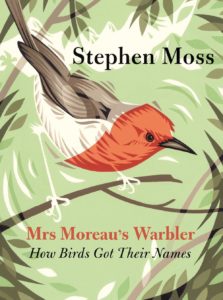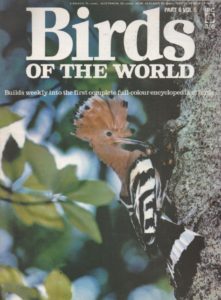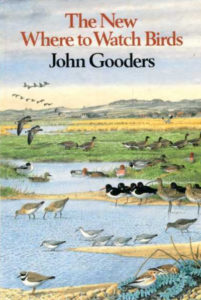>
A couple of months ago I drove half an hour south-west from home to visit Stephen Moss in Somerset and talk to him about his new book, Mrs Moreau’s Warbler: How Birds Got Their Names.
 The interview is part of a new series of podcasts for Faber called Book to Book, in which guests discuss not only their own book but also another title that has been influential to them, perhaps directly, perhaps obliquely.
The interview is part of a new series of podcasts for Faber called Book to Book, in which guests discuss not only their own book but also another title that has been influential to them, perhaps directly, perhaps obliquely.
Stephen kicked off the series by choosing a multi-volume partwork from the 1970s, The World of Birds, thereby setting me the interesting challenge: to seek out all 108 parts on eBay, which might be a long-term project as some of them seem hard to come by, or talking to him about it making use of what I could glean about WoB from the Internet. I chose the latter course, and was pleased to discover that The World of Birds was not edited by some faceless team that evaporated without trace, but by a very influential figure in the world of British twentieth-century ornithology, the late John Gooders.
Bird, n. The general name for the young of the feathered tribes; a young bird; a chicken, eaglet, etc.; a nestling. the only sense in Old English; found in literature down to 1600.
So what were adult birds called? Until long after the Norman Conquest they were known as fowls, from the Old English ‘fugol’ (or in Beowulf, ‘fugle’).*
*Closely related to the modern Dutch and German words for bird, Vogel.
Here’s a lightly edited transcript of the part of our conversation in which we talk about John Gooders, The World of Birds, and how Stephen became ensnared by that world in the first place. If you listen to the whole interview (above), you’ll also learn some fascinating things about the origins of bird names and find out which is probably the oldest surviving bird name in the English language. You can find out more about Stephen here and about his book here.
Stephen Moss
My mother was a single parent, so she devoted a lot of time to me back in the 60s and 70s when I was growing up. She wasn’t interested in birds at all, but she encouraged my interest and took me all over the place and ferried me around before I could cycle or drive myself. And she also, even though she left school at 15, had a real love of books and of reading and encouraged me from a very, very early age. And really the passions of books, language and birds come together in this book.
George Miller
Tell me, going back to your childhood, what age were you when you first registered some interest in birds?
Stephen Moss
I actually can’t remember not being interested in birds because it happened when I was about three years old. My mother took me down to the River Thames at Laleham in West London to feed the ducks. And I asked her what ‘those funny black ducks’ were and she said, ‘I don’t know, dear, but we’ve got a bird book at home’. That was the Observer’s Book of Birds, which ages me. And I looked up and of course they were coots. Fortunately, coots are black and white, like all the illustrations in the Observer’s Book. Most of them. And so I don’t remember not having that passion. We used to go on family holidays around southern England – Devon, Hampshire, Dorset – and watch birds, and later we started going to specific places to watch birds both locally and elsewhere in Britain.
George Miller
So when the Birds of the World partwork started to appear you were a dead cert for that…
Stephen Moss
 Yes, I think I must have been about nine years old and there was a real trend for partworks back in the late 60s and early 70s. And this partwork came out – I think it was one hundred eight parts, nine volumes – and my mother subscribed to it and every week we’d get a copy. And one week I was looking through it and they had a list of all the birds in the world for each family in it. And I looked through this and I was very interested in warblers and hadn’t really seen any warblers at this point. I was 10 years old by the time this came out. And they were sort of mysterious, exciting birds. And I looked down sort of familiar blackcap, whitethroat, reed warbler, sedge warbler, willow warbler, chiffchaff – and got to Mrs Moreau’s warbler and I was really intrigued by that and that stayed with me all these years. It was only relatively recently when I decided to write the book on bird names, I thought that would make a good title: let’s find out a bit more about Mrs Moreau. And I did.
Yes, I think I must have been about nine years old and there was a real trend for partworks back in the late 60s and early 70s. And this partwork came out – I think it was one hundred eight parts, nine volumes – and my mother subscribed to it and every week we’d get a copy. And one week I was looking through it and they had a list of all the birds in the world for each family in it. And I looked through this and I was very interested in warblers and hadn’t really seen any warblers at this point. I was 10 years old by the time this came out. And they were sort of mysterious, exciting birds. And I looked down sort of familiar blackcap, whitethroat, reed warbler, sedge warbler, willow warbler, chiffchaff – and got to Mrs Moreau’s warbler and I was really intrigued by that and that stayed with me all these years. It was only relatively recently when I decided to write the book on bird names, I thought that would make a good title: let’s find out a bit more about Mrs Moreau. And I did.
George Miller
And we won’t spoil it for readers by saying what you found out, but it bookends the whole story, doesn’t it?
Stephen Moss
Yeah, I can hint a few things… I’ve found a lot about Winnie Moreau. Winifred Moreau was married to Reg, who was a very eminent ornithologist, but she wasn’t some sort of passive partner. She did a lot of very good work in her own right. I think nowadays she would probably have co-written books with him and been recognised, but in those days she was a mother and wife – this is back in the 1920s 30s,40s.
They lived in Africa and they discovered a bird, which Reg named after her. I always love this because a friend of mine when he saw a photo of Reg Moreau said, ‘Gosh, he looks like Captain Mainwaring from Dad’s Army!’ Men like that were quite sort of buttoned up. it turned out Reg wasn’t really like that at all; he was quite a character, as was she. She used to keep baby birds that she was trying to raise, if the parents had been killed, in her bra and they used to emerge at dinner parties and slightly shock local dignitaries. So she was quite a character.
George Miller
That kind of anecdote didn’t feature Birds of the World, did it?
Stephen Moss
There was nothing in Birds of the World. There was literally nothing about this bird apart from its name. It was Mrs. Moreau’s warbler, something like Scepomycter winifredae I can’t pronounce it. Winnifredae, so I thought she’d probably call Winifred. I didn’t really think of it again for probably another forty years.
George Miller
So the weekly arrival of this partwork was a highlight in your household; you would pore over it as soon as it came in.
Stephen Moss
Yes, I mean, bear in mind it is the late 1960s, early 70s, you know, we were very bored a lot of the time. the idea of a magazine devoted entirely to the world’s birds popping through the letterbox and me began to read it was literally the highlight of my week apart from West Ham occasionally winning a football match. It was so different from nowadays. Now one of the problems with getting children interested in nature is of course they’ve got so many other wonderful things they can get interested in and so many other distractions. We didn’t really have that. It was really quite dull being an only child in suburban West London in around 1970.
George Miller
When I was reading your book, I was able to go on YouTube when I came to bird and you were writing about its call or something. Able to go on YouTube, see video of it, hear its call. And to you and in the 70s that would have been unimaginable.
Stephen Moss
Completely unimaginable. My mother would take me up to the Natural History Museum so at least I could see the stuffed and mounted skins of birds. I remember seeing my first spoonbill in the Natural History Museum and thinking how small it looked. I thought I would never see a live spoonbill, a very rare visitor to Britain. Of course, eventually I did, but you know when at that age you’d read about these birds from around the world, you never imagined you could ever possibly see them for yourself. And that’s been one of the joys of my life, of being able to gradually travel the world, both with my work as a TV producer and as a writer, and just for what my wife calls ‘jollies’ and see a lot of these really exciting birds that I read about in those pages so long ago.
George Miller
Now before we leave Birds of the World, you probably didn’t know it then, but the man who was the general editor was quite an important figure in the history of British ornithology, wasn’t he?
Stephen Moss
 Yes, John Gooders was an extraordinary man. To my regret I never met him. I saw him at Birdfair once. I know his widow. He died relatively young, I think, in his late 60s or early 70s few years ago. He was an enormous influence on me, not just through editing Birds of the World, but he also wrote a guide which was the sort of bird equivalent of the Good Food Guide called Where to Watch Birds and that came out when I was seven, eight years old, and that became our Bible.
Yes, John Gooders was an extraordinary man. To my regret I never met him. I saw him at Birdfair once. I know his widow. He died relatively young, I think, in his late 60s or early 70s few years ago. He was an enormous influence on me, not just through editing Birds of the World, but he also wrote a guide which was the sort of bird equivalent of the Good Food Guide called Where to Watch Birds and that came out when I was seven, eight years old, and that became our Bible.
My friend Daniel and I would scrutinise what John Gooders said about these various places, everywhere from Wimbledon Common to Minsmere, you know, very famous bird reserves, and the Scottish islands to little local ones. I actually wrote to him and said ‘Why haven’t you got Bushy Park in your book? Because that was where my friend Daniel lived and we’d go out there and watch birds. and he did write back, bless him, and said, ‘Look, I’m sorry, I couldn’t fit everywhere in but maybe if we do another edition, but I’d probably do Richmond Park because it’s bigger’, which is a very good answer. Very kind of him to think of writing back. But he was an enormously influential figure. It changed his life. He wrote that book and of course in those days if you wrote a book about where to watch birds, it became a bestseller. He gave up teaching and spent the rest of his life writing books on birds, which isn’t a bad deal, is it?
